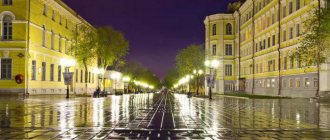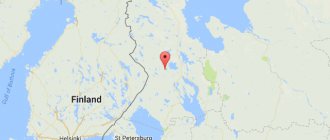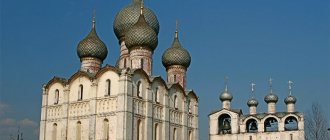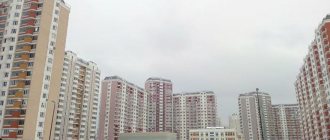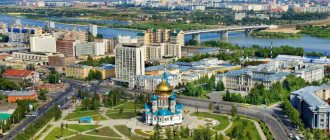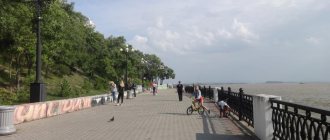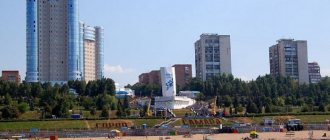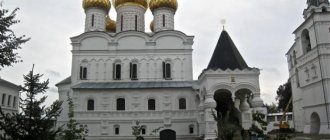| Tambov |
Tambov
, a city in Russia, the administrative center of the Tambov region and the Tambov Metropolis, the cathedral center of the Tambov diocese. Located on the Tsna River (Oka basin), 460 km southeast of Moscow. Population 283.8 thousand (2012).
- On the map: Yandex.Map, Google map
The city was founded on April 17, 1636 on the marshy, wooded banks of the Tsna River, in the place where the Studenets River merges with it. By decree of Tsar Mikhail Fedorovich, steward and governor Roman Boborykin began construction of the fortress city of Tambov to protect the Moscow state from nomads. The original name of the city was written “ Tonbov
” and was associated with the supposed site of the founding of a fortress on the Lipovitsa River “opposite the extreme Mordovian village of Tonbov” and the Tonbov River. Although the city was founded in a different place, it retained its original name. The root of the word is most likely of Moksha origin (“tonbo” - whirlpool). The fact of the founding of Tambov is reflected in an ancient chronicle written in 1788 by an unknown author.
As the borders of the Russian state moved south, Tambov by the end of the 17th century lost its former significance as a military guard fortress. In 1708, Tambov, as a district city, was assigned to the Azov province. Its connections with Moscow, the cities of the Black Earth Region and the Volga region are expanding.
In 1719, it became the center of the Tambov province, which became part of the Azov province, later (in 1732) renamed the Voronezh province. In 1779, it became the administrative center of the Tambov governorship, which in 1796 became known as the Tambov province. The province included 13 cities.
In the middle of the 19th century, the construction of stone buildings began in Tambov - a guest courtyard, government offices, a men's gymnasium and the Alexander Institute. The formation of the city center ended at the end of the 19th century with the construction of the Naryshkin reading room, the building of the State Duma and the Assembly of the Nobility.
In the 19th century, Tambov was a major center for grain wholesale trade. Industry developed slowly and in 1913 it provided only 2% of the total industrial output of European Russia. Before the October Revolution, the largest enterprises in Tambov were railway workshops (800 workers) and a candle factory (85 workers). In addition to them, there were about 30 small semi-handicraft factories.
The February and October revolutions of 1917 took place quite peacefully in Tambov.
In August 1919, during the civil war, the city was captured by the cavalry of General Mamontov. In 1920-21, the city was engulfed in a peasant uprising led by A.S. Antonov.
In 1928, the Tambov province was included in the Central Black Earth Region, and with the dissolution of the Central Black Earth Region in 1934, it was included in the Voronezh Region.
In 1937, the Tambov region was formed, which included the territory of the Penza and Tambov regions; in 1939, the boundaries of the region were revised.
During the Great Patriotic War, a large number of hospitals were opened in the city, and the city was bombed.
Fortress on the Tonbov River
The city arose as a fortified point of the Moscow state in the Wild Field - the undelimited Black Sea and Azov steppes. The sparsely populated territory between the Dniester in the west and the Don in the east, quite suitable for the development of agriculture, cattle breeding and crafts, suffered periodic raids by steppe nomads. To protect the royal lands from enemy invaders, in the first half of the seventeenth century, a fortress was founded, consisting of a fort and the city itself (the Kremlin). The location for the stronghold was chosen on a hill at the confluence of the Tsna and Studenza rivers. The founder of Tambov is considered to be the Shatsky voivode and sovereign steward Roman Boborykin.
The construction of a number of defensive fortresses and fortifications required great efforts from the small local population and a small garrison. However, the spending was not in vain. A reliable barrier was erected to the Tatar raids. One of the modern legends about the founding of the settlement says that the name of the city came precisely from the nomads who, making fruitless attempts to destroy the fortress, shouted “God is there!”
The population of Tambov in those days consisted of a garrison of a thousand soldiers, peasants who were attracted by fertile lands, and feudal lords who came after the farmers. The number of landowners and villagers is unknown, but data on the uprising of 1670 indicates that the peasants who besieged the fortress numbered about three thousand. The uprising was soon suppressed.
At the end of the seventeenth century, the peasant population of Tambov and the area around the fortifications was mainly engaged in felling and logging. Peter I in those days began to quickly build a navy. Tambov wood became its basis.
Recommendations
Notes
- ^ a b c d f g gram
Law No. 72-Z - "Query result."
- Report “On the condition and use of land in the Tambov region in 2011” [ permanent dead link
] Appendix 1. Distribution of land in the Tambov region by category by city and city (as of January 1, 2012, hectares)), p. 108. Data on January 1, 2012. - ^ a b
Federal State Statistics Service of Russia (2011).
“All-Russian Population Census 2010. Volume 1" [All-Russian Population Census 2010, vol. 1]. All-Russian Population Census 2010 [All-Russian Population Census 2010]
(in Russian). Federal State Statistics Service. - "26. The size of the permanent population of the Russian Federation by municipalities as of January 1, 2022.” Federal State Statistics Service. Retrieved January 23, 2022.
- ^ a b c d
Law No. 232-Z - "On the calculation of time." Official Internet portal of legal information
(in Russian). June 3, 2011. Retrieved January 19, 2022. - Post office. Information and computing center of OASU RPO. ( Post office
).
Search for postal facilities ( Search for postal facilities
) (in Russian) - "Tambov". Lexico British Dictionary
. Oxford University Press. Retrieved August 9, 2022. - "Tambov". American Heritage Dictionary of the English Language
(5th ed.). Boston: Houghton Mifflin Harcourt. Retrieved August 9, 2022. - "Tambov". Collins English Dictionary
. HarperCollins. Retrieved August 9, 2022. - "Tambov". Merriam-Webster Dictionary
. Retrieved August 9, 2022. - Federal State Statistics Service of Russia (May 21, 2004). “The population of Russia, the constituent entities of the Russian Federation as part of federal districts, urban settlements, urban settlements, settlements, settlements of 3 thousand or more people.” [Population of Russia, its federal districts, federal subjects, districts, urban settlements, rural settlements - administrative centers, rural settlements with a population of more than 3000 people] (XLS). All-Russian Population Census of 2002 [All-Russian Population Census of 2002]
(in Russian). - “All-Union Population Census of 1989. The actual population of the union and autonomous republics, autonomous regions and districts, territories, regions, urban settlements and villages. Tambov railway station | Original train ticket | Train tickets | International Airport "Strigino" Nizhny Novgorod, Russian Railways ticket, buy a train ticket, plane flights to Nizhny Novgorod, telephone numbers of the Strigino airport information desk, order train tickets, cost of train tickets, train tickets, booking, files - Nizhny Novgorod Airport - Nizhny Novgorod Airport - airport website Nizhny Novgorod Strigino - INTERNATIONAL AIRPORT NIZHNY NOVGOROD ". Nnov-airport.ru
. Archived from the original on March 13, 2016. Retrieved December 17, 2016. - "Pogoda.ru.net" (in Russian). Retrieved September 8, 2007.
- https://eng.tsutmb.ru/about/
- https://www.lexology.com/library/detail.aspx?g=4e297d5d-2392-4bf7-86fe-fb09c6354b77
- https://rusmania.com/central/tambov-region/tambov
- Monuments of Tambov
Sources
- Tambov Regional Duma. Law No. 72-Z of June 21, 1996 “On the administrative-territorial structure of the Tambov region,” as amended. Law No. 544-Z of June 11, 2015 “On amendments to Article 7 of the Law of the Tambov Region” On the administrative-territorial structure of the Tambov Region “”. Published: “Tambov Life”, No. 131, 1996 (Tambov Regional Duma. Law No. 72-Z of June 21, 1996 On the administrative-territorial structure of the Tambov region
As amended by Law No. 544-Z of June 11, 2015.
On the introduction amendments to Article 7 of the Law of the Tambov Region “On the administrative-territorial structure of the Tambov Region”
. - Tambov Regional Duma. Law No. 232-Z of September 17, 2004 “On establishing boundaries and determining the location of representative bodies of municipalities in the Tambov region,” as amended. Law No. 606-Z of December 7, 2015 “On amendments to the Law of the Tambov Region” On establishing boundaries and determining the location of representative bodies of municipalities in the Tambov Region “”. Came into force on the date of official publication. Published: “Tambov Life”, No. 185 (23125). (Tambov Regional Duma. Law No. 232-Z of September 17, 2004. On establishing boundaries and determining the location of representative bodies of municipalities of the Tambov region.
As amended by Law No. 606-Z of December 7, 2015.
On amending the Law of the Tambov Region “On Establishing boundaries and determining the location of representative bodies of municipalities of the Tambov region "
. Valid from the date of official publication.).
Center of Tambov Viceroyalty
In the eighteenth century, the settlement acquired almost the status of a city: in the first half of the century, the first educational institution was opened there - a soldiers' garrison school. But not many villages near defensive fortresses in Russia at that time could boast of educational centers! In fact, Tambov became a provincial center only after the transformation of provincial government carried out by Catherine II in 1775.
Despite its status as the center of governorship, Tambov remained a “big village”. Wooden houses with thatched roofs, narrow streets without pavements, vegetable gardens and farm yards - all this made up the urban landscape of that time. But the capital’s architects had already begun to develop a development plan at that time. A few more years will pass, and several large buildings, a guest house and public schools will appear in the settlement.
In 1785, Gabriel Derzhavin was appointed ruler of the viceroyalty, whose memory is dear to every native resident of the city. Today the university bears the name of the then mayor. It is not surprising that the population of Tambov treats the poet with great love: he developed shipping along the Tsna and book printing.
Infrastructure Features
Life in Tambov varies in terms of comfort, since not all areas are connected by transport to the center; there are not enough hospitals, shops, supermarkets, parking lots, kindergartens and schools everywhere.
All these points need to be paid attention to before moving and buying an apartment, since this directly affects the standard of living in Tambov.
The housing stock of Tambov is represented by “Khrushchev”, “Brezhnev” and “Stalin” buildings
New residential complexes, microdistricts, neighborhoods, cottage communities and townhouses are also being built.
Old houses are either demolished or renovated, but this does not solve the problem with a large number of dilapidated housing in the city. In the old building, as city residents say on forums, there are often interruptions in heat, lighting, and power supply.
Housing and communal services tariffs
The housing and communal services problem is one of the most serious, according to citizens.
On average, Tambov residents pay 3 thousand rubles for utilities in January. Half of this amount goes to pay for heating. In the warm season, a communal apartment costs 1 thousand rubles. Additionally, you need to pay for house cleaning - 60-100 rubles / month, as well as internet - up to 400 rubles. per month.
In many ways, the cost of housing and communal services depends on the company servicing the neighborhood, as well as on the type of house.
- In modern houses, energy-saving technologies are used during construction to help reduce heat consumption.
- In old houses, there may be huge gaps between the walls, which take a lot of time and money to patch. In such houses and apartments it is cold in winter, and you have to pay a lot for heating.
Public transport
The standard of living is determined by the transport system, the development of roads within the city and in Tambov itself.
The road surface is quickly repaired in various microdistricts of the city, but in the suburbs this is difficult
Due to the increase in traffic on highways and city roads, the Tambov administration began expanding roads. Overground and underground passages are being built to make pedestrian movement safe.
In Tambov there are minibuses, buses, and trolleybuses. There are no tram tracks, as they are not included in the city development plan. Problems with transport are caused by the fact that buses only run until 20–23 pm, which prevents people from getting to remote areas of Tambov.
The situation is gradually improving, as the mayor’s office opens new routes, introduces more buses and trolleybuses on morning and evening routes, and creates “smart stops.”
Educational institutions and hospitals
Parents of children of different ages need to find out more information about kindergartens in Tambov. There are difficulties with such preschool institutions, as elsewhere in the country.
There are many kindergartens in the districts, but their number needs to be increased. Immediately after the birth of a child, parents put the baby in line to take him to the garden near the house.
Universities and schools in Tambov provide modern education. There are city and private secondary educational institutions - classical schools, lyceums, colleges.
Tambov residents and residents of neighboring settlements receive higher education in a wide range of professions in the following institutions:
- A technical and humanities university, they have many students from Africa, Asia, including China, Turkey and Korea;
- technical schools;
- schools;
- branches of other Russian universities.
Tambov State Technical University
Hospitals, like educational institutions, are divided into public and private. Only medical institutions are not open in every microdistrict of Tambov. The cost of medical services and drugs depends on the type of ownership of the hospital and pharmacy.
Before buying an apartment, you need to clarify how to register with the clinic and provide the patient’s personal card. You must also contact the local branch of the Pension Fund to transfer your pension and other social benefits from one city to another.
You don’t have to change your pension certificate, you just need to collect all the papers in order to receive payments from the Pension Fund on time.
Prices in stores
Local supermarkets and hypermarkets have a huge selection of goods, the cost of which is the same as in other regions of the country.
Current prices for products in Tambov are listed below:
- butter, 170 gr. – 76.9 rub;
- log cheese - almost 500 rubles/1 kg;
- sour cream, 180 gr. – about 40 rubles;
- amateur loaf – 26.9 rubles;
- Darnitsky bread – 17.9 rubles;
- suluguni – 441 rub./1 kg;
- Doctor's sausage – 260 RUR/1 kg;
- fresh frozen fish – 149.9 rubles/1 kg;
- baguette – 17 rubles;
- salami in Finnish - about 361 rubles;
- milk, 900 gr. – 54.9 rub;
- wheat flour – 55.9 rubles/2 kg.
- Sugar – 34.9 rubles/1 kg;
- chicken – 116.9 rub./1 kg.
For vegetables and fruits, it is best to go to bazaars and markets operating in different parts of the city. There, local farmers offer their products to residents.
You can buy food at any time of the day in shops and supermarkets that are open around the clock.
The granary of the Russian Empire
With the beginning of the nineteenth century, Tambov changed significantly: the settlement began to look more like a city, and the Kazan and Tenth Fairs made it a center of trade: a wide variety of goods were brought here, and the squares turned into a continuous market for several days. The Tambov province, in addition, became the main breadbasket of the Russian Empire. Some of the grain grown on the lands of the Wild Field even went abroad.
The first official data on the number of city residents dates back to the year before the Patriotic War of 1812. At that time, the population of Tambov was 16,800 people. Most of them either worked in the fields or were engaged in trade. A small part of the townspeople made their living from handicrafts.
In 1812, with the outbreak of war, a people's militia numbering twelve thousand people was formed in the provincial center. Some of the soldiers were from the local population, others were sent from settlements in the area. As the French approached the capital, people from towns near Moscow began to arrive in Tambov. Captured soldiers and officers were also sent here.
Century XX
The beginning of the century coincided with the beginning of the emergence of industrial production in the city. The province was exclusively agricultural, in which a large number of wealthy peasants lived. Tambov, where there were very few representatives of the working class, greeted the February and then the October revolutions of 1917 with great enthusiasm. This was due to the distribution of land, according to the “Decree on Land” proclaimed by the Bolsheviks.
The peasants began to arbitrarily seize the land of landowners and large landowners, but ran into resistance from the authorities. Mass conscription into the Red Army began as the Civil War was raging. This caused discontent. The region became a hotbed of strong uprisings against Soviet power, the most famous of which was the Antonovsky rebellion. They were all brutally suppressed.
The Soviet years were marked by the opening of new schools, which were formed in connection with the elimination of general illiteracy. In the 60s, the industrialization of the city began. New enterprises were built and put into operation. A huge amount of housing has been built. Clinics, kindergartens, stadiums, music schools and much more were opened. Everything that Tambov has today was built during the Soviet years.
Statistics 1840
By the end of the first half of the nineteenth century, there were forty-five streets in Tambov, including two embankments of the Studenets and Tsna rivers, as well as eight alleys. There were more than two thousand private houses, but only sixty-nine of them were made of stone. Visitors could use the services of three hotels. The population of Tambov rested in seven taverns, five taverns, twenty drinking houses, and eight damask shops. There were seven clothing and dry goods stores, and twenty-five inns. Eight wells were installed to ensure water supply.
The population of Tambov was the same 16,800 people. Young people could study in gymnasiums and colleges. The Alexandrinsky Institute of Noble Maidens and a cadet corps were built - all this made the city of Tambov quite large and wealthy at that time. Social protection of the population was represented exclusively by hospitals, where locals could get doctor's advice. The Ascension Convent and the Kazan Monastery were also erected in the city.
All this data is provided by Staff Captain Kuzmin. In addition, statistical information was contained in the Military Statistical Review of the Russian Empire, in the section concerning the Tambov province.
Kazan Monastery
Founded in the 17th century by Elder Joseph, the monastery is famous for the tallest bell tower in Russia. By decree of Catherine II, a theological seminary was opened at the monastery. The library stored more than 50 thousand unique books and manuscripts. The temple preserves frescoes made by Italian artists. After several decades of decline, the buildings were restored and the seminary was reopened, where a Sunday school operates.
Location: M. Gorky, 3.
Ascension Monastery
One of the most elegant monasteries in the Tambov region was built in the 17th century in the northern part of the city. The first abbess was Catherine, sister of Pitirim. During its history, the convent burned down, was rebuilt again, closed after the revolution and began its activities again. The icon of the Kazan Mother of God was kept within its walls; later it was transferred to the Shatsk Vyshenskaya Hermitage.
Address: Moskovskaya, 37.
Industrial growth
Since the beginning of the twentieth century, Tambov has experienced active industrial growth. There is not only quantitative, but also qualitative growth of enterprises. The city ranked first in the empire in shag production. At the same time, joint stock companies and industrial companies began to be created.
In 1919, with the establishment of Soviet power, which took place in Tambov with great intensity, it opened, whose task was to repair and manufacture military equipment. The enterprise operated on the basis of former artillery workshops. Thus, the population of Tambov and the Tambov region was provided with jobs with good salaries.
Peasant revolts
After the revolutionary events in Petrograd, the population of the center of the province expected a fair solution to the land issue. However, the lack of reforms became the reason for the unauthorized seizure of landowners' lands by peasants. In the summer of 1917, more than three hundred peasant encroachments on the property and land holdings of local landowners were recorded.
Major revolts on Tambov soil continued from 1917 to 1921. The anti-Soviet movement died out when the government adopted a decree “On the temporary distribution of land,” which was what the peasants demanded from the very beginning.
Tambov under Soviet rule
The Soviet government made every effort to develop industry and culture in Tambov and improve the city. Almost immediately after the end of the uprisings, the theater began operating under the leadership of Stanislavsky’s student. In 1928, the work of the Tambov Carriage Plant was launched, in 1932 Avtotractorodetal was founded, and in 1933 it was opened. Almost all production facilities of the enterprises were based on the former workshops of local entrepreneurs.
Work was actively carried out to eliminate illiteracy. A pedagogical institute opened in 1930, a Puppet Theater appeared in the city in 1934, and a philharmonic society in 1937. At the same time, the settlement became the largest book depository in the Tambov region.
In 1936, the question was raised about renaming the city to Tukhachevsk, in honor of M. N. Tukhachevsky, a Soviet military leader. After being trumped up on charges of organizing a conspiracy to violently seize power, Tukhachevsky was repressed. The question of renaming was dropped.
The city's prosperity peaked in the seventies and eighties of the twentieth century. Over the course of fifteen years, more than two dozen social facilities were built, and residential areas of typical Soviet construction were actively built. What population in Tambov was recorded by statisticians in the “best times”? The number of citizens as of 1987 was 305 thousand people.
Current position of the city
Now Tambov is a large populated area. It is distinguished by its favorable geographical location, relative proximity to the capital, and large highways connecting the city with the south and center of Russia. In the last decade, the amount of garbage here has increased, but this fact has little effect on the environmental situation: Tambov remains one of the fairly clean and green cities in Russia.
The Tambov Employment Center provides citizens with a sufficient number of vacancies due to the need to find workers for the construction of new microdistricts, supermarkets and other facilities. Trade employees are also required.
The population of Tambov is provided with everything necessary for a comfortable life, but there are also certain problems. The latter include insufficient water and heat supply, which is especially important for residents of the Oktyabrsky district, inflated tariffs for housing and communal services, and inappropriate maintenance of stairwells and basements. In terms of crime, the situation is good.
Famous people
- Andrei Kolmogorov (1903–1987), mathematician
- Konstantin Fahlberg, chemist known for artificial sweeteners Saccharin
- Sergei Rachmaninov, musician
- Alexander Lodygin, electrical engineer
- Nikolai Fedorov, religious philosopher
- Lev Kuleshov, director
- Ida Kar, photographer
- Victor Merzhanov, pianist
- Anastasia Rodionova, tennis player
- Arina Rodionova, tennis player
- Yuri Zhirkov, football player
- Daria Trubnikova, rhythmic gymnast
- Tambov Bratva, a well-known (still active) criminal group from Tambov, covering many regions of Russia.
- Maxim Mysin, football player
See also: List of people from Tambov
Today's demographic situation
What is the population of the city of Tambov now? At the moment, the demographic picture is unfavorable. Almost 285 thousand people live in the city. Natural population decline and migration of city residents to other regions are the reason that Tambov ranks third in terms of the highest rates of decline. The population is declining, and the process is stable and has practically not stopped since the nineties.
Of course, the Tambov Department of Social Protection of the Population is striving in every possible way to stimulate a change in the situation for the better. But the birth rate exceeded the death rate, which caused an increase in the population, not for long: since 2010, the number of residents has gradually increased, but in 2016 a negative figure was again recorded. Then the population of Tambov decreased by about four hundred thousand people. Now, as already mentioned, the number of citizens is almost 285 thousand.
What is the population of the city of Tambov? By ethnic composition, the majority of townspeople are Russians (almost 95%). The following ethnic groups follow:
- Ukrainians (0.67%);
- Armenians (042%);
- gypsies (0.38%);
- Tatars (0.21%)
- Azerbaijanis (0.18%);
- Yezidis - an ethnic group professing Yezidism (0.17%);
- Belarusians (0.14%) and others.
The majority of Tambov residents (about eighty percent of the population) profess Orthodoxy, there are also Old Believers, Catholics, Baptists and representatives of other religious communities and beliefs.
Climate
Tambov has a humid continental climate (Köppen climate classification Dfb
). The average temperature of the coldest month (February) is about -8 ° C, the warmest month (July) is about +20 ° C. Due to its southern location, the average annual temperature in Tambov is about 2 degrees higher than in Moscow. Annual precipitation ranges from 400 to 650 mm, of which more than half (about 270 mm) falls in the warm season. The duration of the warm period is 154 days.
| Climate data for Tambov | |||||||||||||
| Month | Jan | Feb | Mar | Apr | May | Jun | Jul | Aug | Sep | October | But I | December | Year |
| Record high °C (°F) | 6.6 (43.9) | 8.5 (47.3) | 17.6 (63.7) | 29.7 (85.5) | 36.1 (97.0) | 38.8 (101.8) | 41.1 (106.0) | 41.0 (105.8) | 35.2 (95.4) | 26.5 (79.7) | 14.6 (58.3) | 11.8 (53.2) | 41.1 (106.0) |
| Average high °C (°F) | −4.5 (23.9) | −4.3 (24.3) | 1.6 (34.9) | 13.2 (55.8) | 20.9 (69.6) | 24.4 (75.9) | 26.5 (79.7) | 25.0 (77.0) | 18.5 (65.3) | 10.2 (50.4) | 1.2 (34.2) | −3.5 (25.7) | 10.8 (51.4) |
| Daily average °C (°F) | −7.5 (18.5) | −7.9 (17.8) | −2.4 (27.7) | 7.5 (45.5) | 14.5 (58.1) | 18.4 (65.1) | 20.4 (68.7) | 18.7 (65.7) | 12.7 (54.9) | 6.1 (43.0) | −1.4 (29.5) | −6.3 (20.7) | 6.1 (43.0) |
| Average low °C (°F) | −10.5 (13.1) | −11 (12) | −5.8 (21.6) | 2.7 (36.9) | 8.7 (47.7) | 12.9 (55.2) | 14.9 (58.8) | 13.2 (55.8) | 8.2 (46.8) | 2.8 (37.0) | −3.7 (25.3) | −9.1 (15.6) | 1.9 (35.4) |
| Record low °C (°F) | −38 (−36) | −36.9 (−34.4) | −30.4 (−22.7) | −15.3 (4.5) | −4 (25) | 0.4 (32.7) | 4.4 (39.9) | 2.5 (36.5) | −3.7 (25.3) | −14.7 (5.5) | −29.3 (−20.7) | −36.1 (−33.0) | −38 (−36) |
| Average precipitation mm (inches) | 37 (1.5) | 31 (1.2) | 27 (1.1) | 26 (1.0) | 42 (1.7) | 72 (2.8) | 54 (2.1) | 44 (1.7) | 53 (2.1) | 46 (1.8) | 45 (1.8) | 41 (1.6) | 518 (20.4) |
| Source: Pogoda.ru.net[24] | |||||||||||||
Economic situation
The Tambov Employment Center reports that the average salary in the city is twenty-nine thousand rubles. But in fact, you can only count on ten to twelve thousand. This is the salary that applicants are offered at most jobs. In addition, it is believed that it is almost impossible to get a good position without making contacts. This assumption, unfortunately, is close to the truth.
The labor market is determined by a large number of shopping centers. The Employment Center (Tambov) currently offers vacancies mainly in the field of trade and services. Conditions at such enterprises are not the best:
- irregular working hours;
- work on holidays and weekends;
- no extra pay for night shifts.
There are vacancies at industrial enterprises. For example, a dairy plant provides jobs to a large number of city residents. Hard work in a distribution center pays quite well.
The Tambov Employment Center from time to time offers vacancies from factories. This kind of work is not popular in the city and does not require high qualifications, but allows you to earn a decent salary. The city has a confectionery factory, a bread equipment manufacturer, Pigment, a chemical enterprise, and Revtrud, a supplier of communications equipment, consumer goods, and construction materials.
Vacancies at the employment center (Tambov) are rarely filled with popular positions of managers or administrators, but such advertisements can be found in local newspapers. True, under the beautiful cover of office work, vacancies for sales representatives are often hidden.
The city's attractions
The most recognizable symbol of the city is the Tambov wolf, whose image is depicted on souvenirs. There is no artistic representation of the wolf in the city, only a small wooden sculpture stands at the entrance.
In the center, on Lenin Square, there is a monument to Vladimir Ilyich. Nearby is a monument to Zoya Kosmodemyanskaya, the first woman to be awarded the title of Hero of the Soviet Union, a native of the Tambov region. And the calling card of Tambov is the embankment. The Tambov Peasant Monument can also be called a colorful attraction, and seekers of new sensations should visit the Museum of Sin, where unusual exhibits are collected - fragments of the human body and internal organs.

